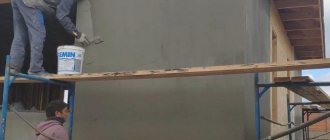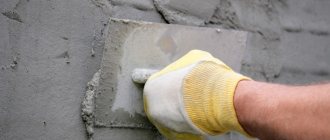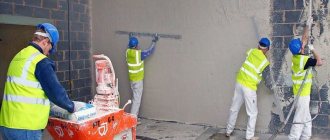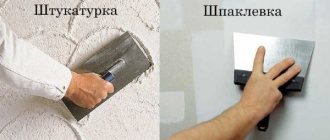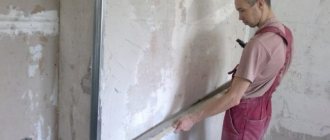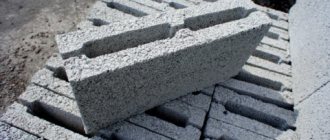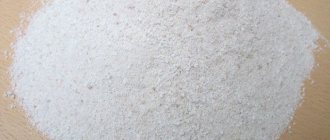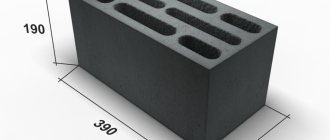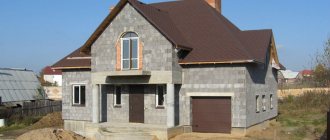Any building made of expanded clay concrete blocks needs plastering. This allows you to protect the walls from negative factors and extend their service life, and therefore the entire building as a whole. Finishing can be done in other ways, but this technique allows you to cope with the work at the lowest cost.
You can find many varieties of plaster on sale today; it can be made from cement and sand, gypsum and other components. Each of these compositions has its own advantages and disadvantages. For example, with a cement-sand mixture, the advantage is the aesthetics of the result, but gypsum plaster has a lighter mass and has more impressive thermal insulation properties. The latter allows you to achieve a good result in terms of the evenness of the wall, and the first forms the most durable layer.
What and how to plaster walls made of expanded clay concrete blocks?
Protecting the surfaces of buildings made of expanded clay blocks provides resistance to the destructive effects of climate, improves operational characteristics and comfort of stay, preserves the durability of the stone, and creates the basis for subsequent decoration. The simplest, most accessible and least expensive solution is plastering of expanded clay concrete masonry.
Types of plaster
Surfaces made of expanded clay concrete blocks are plastered with cement-sand and gypsum mixtures. Plaster reduces the thermal conductivity of walls and provides the correct gradient of vapor permeability. Ease of use and adhesion strength to expanded clay concrete walls are higher with sand-cement plaster. However, the surface of masonry stones unevenly absorbs moisture from the mortar, which can lead to fragmented shrinkage and disruption of the aesthetics of the surface. Another danger is possible weak adhesion between the plaster and the wall surface.
Cement-sand
The plaster goes well with wall blocks due to the identical compositions. It is ideal for tightly closing pores, cracks and smoothing seams, which is important with constant changes in humidity and air temperature. This plaster can be easily painted to form the desired exterior façade or interior walls. Plastering creates additional pressure on the foundation, which should be taken into account.
Advantages
Cement-sand plastering is the simplest and most aesthetic finishing method. The composition of the mixture has high adhesion to the base of expanded clay blocks, which creates a durable coating. It is better to cover masonry in rooms with high internal humidity with this mixture. This coating saves the project budget.
This material has a lower density and increased thermal insulation properties compared to a cement-sand mixture. This type of plaster does not adhere well to the base unless ingredients with concrete contact properties (or ready-made dry mixtures) are used.
Advantages
In terms of performance characteristics, plastering with a gypsum-based mixture is similar to a sand-cement composition. However, the material itself per unit area (with the same layer thickness) is lighter than the cement-sand mixture and somewhat warmer. The exterior of the finished surface can be perfectly smooth.
Expanded clay blocks
Expanded clay concrete is a modern and very easy-to-use building material for country houses. Building an expanded clay concrete house is not at all difficult. Such a building will be no less reliable than a brick one, and all the work will cost much less.
Expanded clay (burnt clay) and a mixture of cement and sand are used to make blocks. The clay filler makes artificial stones light and completely harmless to the human body and the environment. The structures turn out to be dry and well “breathable”, since they are completely vapor permeable.
A mixture of concrete and expanded clay does not absorb moisture as well as foam concrete with similar properties. And moisture resistance directly affects thermal insulation abilities. Compared to brickwork, thermal conductivity is one and a half times lower, and compared to foam concrete - almost two times lower (of course, walls of the same thickness are compared). In the construction of one- and low-story houses, expanded clay concrete has been successfully used for several decades.
The size of one block is 7 times larger than bricks, but at the same time it has a mass 2.5 times less. Therefore, the work is completed quite quickly, and even a novice mason can handle it. Professionals can lay approximately 3 cubic meters of expanded clay concrete per day. Brick construction is on average three times slower.
Due to the size of expanded clay concrete blocks, cement mortar is also required significantly less than for laying bricks. Depending on the installation method, the thickness of expanded clay block walls can be different. When building low-rise (one- or two-story) houses in the southern regions, you can make walls no more than half a meter thick, but, however, only if the exterior is finished with insulation and plaster or facing stone.
For northern areas, where cold winters are a constant phenomenon, the walls should be thicker. For residential buildings, the optimal thickness is 80 centimeters. If the premises are non-residential and there is no heating in it, then a thickness of 20 centimeters and sheathing with insulation is quite suitable.
Due to the high strength of expanded clay concrete, multi-story buildings can be erected from it, but, however, this will require additional reinforcement with steel rods.
An expanded clay concrete wall does not have a very attractive appearance, so even if external insulation was not planned, you should still think about cladding the outside. After all, this will also have practical benefits, since, despite the low hygroscopicity, the wall will certainly begin to crack and gradually collapse from temperature changes and freezing water in a couple of years.
Is it necessary to insulate the outside of an expanded clay concrete house?
At the moment, the construction of houses from expanded clay concrete blocks is gaining popularity. Let's try to figure out if this material is so good. Expanded clay concrete blocks have good thermal insulation, relatively inexpensive cost and low weight.
The use of expanded clay concrete blocks as the main building material of your home is completely justified, however, despite all the worthy characteristics of this material, it is worth paying special attention to the insulation of the house from the outside.
Let's say frankly that the house needs additional external insulation, even if the expanded clay concrete blocks were laid in two rows. This is most relevant for areas where the temperature is predominantly low. If you do not pay special attention to insulation, cracks may appear in the house, even if the quality of the blocks meets all standards.
In addition, finishing the outside of the house protects it from environmental factors, guarantees thermal insulation, waterproofing and soundproofing of the walls. If you only insulate a house from the inside, condensation will form between the insulation and the wall material, and this will, over time, lead to significant damage to the expanded clay concrete blocks.
Let's look at the most common methods of insulation.
Brick cladding
This method is very effective, since brick has high thermal conductivity, but entails quite high costs due to the considerable cost of this material.
Insulation with mineral wool
This method is certainly suitable for those regions where the weather is cold throughout the year. Cotton wool weighs a little, is inexpensive, easy to install, and at the same time provides excellent insulation. Additionally, you can install vapor-tight insulation with aluminum foil, then you will definitely not be afraid of any frost.
Foam insulation
This material is lightweight and can be used to insulate any building. Polystyrene foam is the most inexpensive material among modern insulation materials.
We decided that it is worthwhile to insulate a house made of expanded clay concrete blocks from the outside. Let us pay attention to additional aspects of this issue. It is important to pay attention to the protection of the insulation you choose from mechanical and atmospheric influences from the outside. For this, brick cladding is used, which we wrote about earlier, as well as such equally common materials as artificial stone, facade tiles, siding or plaster.
Application technology
The expanded clay concrete surface is pre-cleaned, the masonry seams are processed, and then it is primed. Next, the surfaces are reinforced with mesh. The prepared solution is applied and, after drying, rubbed until ready for decoration.
Preparing the wall surface
Before plastering, any dirt, dust, oil or grease stains on the wall blocks are removed. The mortar that protrudes above the surface of the masonry gets knocked down.
Seam processing
Cracks and seams are sealed with sand-cement mortar. When they are narrow and deep, they are embroidered to allow the material to penetrate. All recesses are aligned to the plane of the wall to ensure more uniform shrinkage of the plaster. The surface must be dry before the next operation.
Before using the gypsum composition, expanded clay concrete blocks are treated with agents that improve mutual adhesion. Liquid quartz primers, polymer dispersions, as well as “concrete contact” type compositions intended for expanded clay blocks can be used. At the same time, you can use ready-made plaster mixtures that already contain additives for similar purposes. Then the blocks will not require preliminary priming.
Before using a cement-sand mortar to level out the suction properties, the masonry areas are treated with a solution of cement in water. It is also possible to simply wet the expanded clay blocks with water when applying the plaster layer. Properly prepared masonry will evenly absorb water from the plaster solution, which will keep it smooth.
Installation of plaster mesh
The use of sand-cement mortar (up to 10 mm thick) does not require reinforcement. However, when the plaster layer is thicker than 1.5 cm, it is better to fill it with a flat galvanized mesh. Fastening is carried out using self-tapping screws, which are installed in dowels into holes made in the masonry every 20 - 30 cm.
The mesh is pressed with thin washers under the screw heads. A relatively thin layer of plaster coating makes it possible to use fiberglass mesh (density 200 g/m2, mesh 10x10 or 5x5 mm). It is advisable to install it before plastering with gypsum mortar.
Preparation of the solution
The ready-to-use solution should have the consistency of liquid mashed potatoes. Plasticizers will make it easier to use. Also, especially in gypsum plaster, you should add components that increase adhesion to the base. The plaster of expanded clay concrete blocks must provide the masonry with moisture resistance, have high strength, adhere well to the base, dampen minor shrinkage changes in geometry and frost resistance.
Before starting, vertical beacons are attached to the solution and leveled in increments convenient for using the two-meter rule. For the first layer, the mixture is thrown onto the masonry with a trowel and smoothed with a rule that moves along the beacons slightly to the right - left and from bottom to top. After 6 - 7 hours, the beacons are removed from the wall, and a 2nd thin finishing layer is applied, eliminating all remaining irregularities.
The solutions dry out quite quickly, as they dry on the outside. The plaster forms a smooth, even surface from under which the relief of the blocks of expanded clay concrete base does not appear.
As it sets, the finishing layer is rubbed with a grater. Complete drying of the cement-sand coating gives the start to finishing: priming with painting, decorative puttying, priming for wallpaper, tiles, porcelain tiles, etc. Gypsum plaster creates a surface almost ready for decorative finishing (wallpaper, painting). The external surfaces of the building covered with plaster should be immediately covered with façade paint, which will protect them from dampness.
Expanded clay concrete block is plastered to level the surface of the masonry, improve the performance properties of buildings and subsequent decoration. Plaster mixtures have application nuances that require consideration.
Technology of applying plaster composition to expanded clay concrete blocks
External and internal application of plaster composition to expanded clay concrete blocks can only be carried out if you have the appropriate experience. To begin with, the surface is prepared, which involves not only removing defects, but also applying a primer.
The most important stage is plastering. If necessary, the solution must be prepared and pigmented. If special equipment is available, mechanized plastering can be performed. With the help of such installations, the solution is mixed without the involvement of a person and quite quickly.
Preparing the wall surface
Expanded clay blocks must be prepared before applying facade plaster to the walls of the house. To do this, all dirt is removed from the blocks, as well as oil stains, as well as everything that can reduce grip. A positive quality is that the layer of plaster mortar will practically not be absorbed into expanded clay concrete blocks, which have low water absorption.
As a preparatory layer, you can combine water with cement to create a solution that is applied before the main layer of plaster. This is true if the finishing is carried out on the basis of cement and sand. Expanded clay concrete masonry turns out to be quite smooth, so a layer of the mixture is poured in such a way as to form no more than 1.5 cm. If the work was not carried out by professionals, then the laying may have some defects, then the consumption of plaster will increase.
Preparation of plaster mortar and its application
If the solution was purchased in dry form, it will need to be combined with water and color added if necessary. Mixing in this case is carried out using a drill, which is turned on at low speed. When the solution is purchased ready-made, it can be applied immediately. Laying should be done with a trowel, and leveling should be done using a rule. To make this possible, beacons are pre-installed. 6 hours after applying the first layer, rub it well, and then begin applying the finishing layer.
Nuances of the work
If the house is not new, then its external walls also need to be freed from old finishing, even if it seems suitable for plastering. Sealing of cracks and seams is carried out flush with the surface. You can also use a ready-made solution for this. Sometimes you buy putty intended for seams. After preparing the laitance for the first layer of primer, the composition must be applied to the surface with a brush. You need to move it horizontally, which will increase adhesion between the layers.
Then you can start filling the mesh. If it is not there, you can replace the layer with staples. An alternative is metal anchors with washers. When placing beacons, you need to make sure that their position is level. In this case, you need to use a level or plumb line. A distance of 1.5 m is left between these elements, which will allow you to conveniently work with the 2 m rule.
The beacons are fastened using cement mortar.
When preparing the mixture yourself, you need to carry out this work using a wide tray. If you don’t have a mixer, you can use a spatula to bring the mixture to the consistency of liquid puree.
The solution can be poured onto the base with a ladle, and smoothing is carried out from the bottom up. The rule is to move not only down, but also left and right. The final layer is applied using a trowel. You need to try to fill all the depressions with the mixture. As soon as this layer has set, you need to grout it with a float, which the master moves at a run or in a circle. Once the plaster has dried, it needs to be primed or painted. Sometimes the surface is covered with any finishing, it can be decorative putty.
Mechanized block plastering
If you decide to decorate your home outside or inside using special equipment, you will receive many advantages. Firstly, the composition can be mixed in a short time, without using buckets and mixers. Secondly, it’s much easier to do this, and you won’t waste any effort. Thirdly, application can be done in an even layer; the machine will do almost everything for you.
The solution adheres well to the surface, and the layer is more durable, because it is supplied under pressure. Less building materials are consumed and labor costs are reduced. If you decide to use the device, you should select a special dry mixture. By finishing the interior walls in this way, you will be able to use any finishing materials for subsequent interior finishing.
Basic requirements for plaster on expanded clay concrete blocks
The simplest and most economical finishing solution is plastering walls made of expanded clay blocks. Plastering walls can be an independent finishing option.
It is also recommended for further finishing with decorative tiles or stone. Application of the plaster composition is necessary to prepare the base of the walls for painting or wallpapering. As an option - finishing with decorative plaster.
Basic requirements for plastering materials for the blocks in question:
- High strength of the resulting coating.
- Creating moisture-resistant protection.
- Good adhesion to expanded clay concrete.
- Sufficient plasticity of the material.
Products made from lightweight concrete have low resistance to mechanical damage to the front surface. The porous structure of the material easily absorbs water, which, accumulating in the pores, eventually leads to the destruction of the material. Therefore, expanded clay blocks require good protection of their surface from moisture and mechanical influences.
Reliable fixation of the plaster layer on the wall is achieved through good mutual adhesion of the materials. To avoid cracking of the plaster due to shrinkage of the wall masonry, sufficient ductility of the materials used is required.
The process of insulation and installation of ventilation facades
So in January, in the very coldest weather, we began insulating the house. 50x50 mm bars were mounted on the KBB walls, which were pre-treated with Senezh fire-bioprotection. First, vertical rows of bars were sewn and the insulation sheets were laid vertically. The next row of 50x50 mm bars was mounted horizontally. Accordingly, the insulation sheets were laid horizontally.
This is how the wooden frame was covered with insulation sheets. The thermal resistance of a 50 mm pine block across the fibers is lower than the thermal resistance of a 50 mm basalt wool sheet at a density of 45.
After that, an Izospan membrane was attached to the stapler to the bars, which was supposed to protect the insulation from moisture and the house from blowing out.
Then 50x25 mm bars were vertically mounted on top, which formed a ventilation gap along the entire facade.
Vinyl and basement siding were then attached to them.
They did not install a vapor barrier on the side of the house, because living in a plastic bag is not the best option.
Types of plaster on expanded clay concrete blocks
Taking into account all the requirements, the following types of plaster compositions with a base can be used for finishing:
Each of these plasters has its own advantages and disadvantages. The disadvantages of any composition can sometimes be corrected by using various additives: plasticizers, hydrophobic fillers.
Wall finishing with mineral-based mixtures
The simplest and cheapest method of plastering is the use of mineral-based compounds.
Depending on the main binder component, they are divided into:
Cement-sand plaster has a number of advantages:
- High adhesion strength to the surface of expanded clay concrete;
- Resistance to water;
- Coating strength;
- Affordable price of materials.
Plastering walls made of expanded clay concrete blocks: types and features
Applying plaster is one of the stages of finishing work, which is responsible for protecting the surface from external influences and preparing the basis for further decorative finishing. There is a larger selection of plaster mixtures for sale for each type of laying material. Below we discuss in detail the plastering of walls made of expanded clay concrete blocks - types of mortar, basic properties and method of application.
Blocks made of expanded clay concrete are a popular material for the construction of residential and non-residential buildings. This material has a large list of advantages, among which the following stand out:
- Strength and durability;
- Resistance to moisture and temperature changes;
- Frost resistance;
- Environmental friendliness;
- High levels of thermal insulation and vapor permeability.
In a room built from expanded clay blocks, there is natural air circulation and it “breathes.” Blocks do not deteriorate over time, do not rot or rust.
Let's take a closer look at how and how to plaster expanded clay concrete blocks? What to use for work? What features should you know before starting work and how to choose the right material?
Types of plaster for expanded clay concrete blocks
For walls built from expanded clay concrete blocks, 4 main types of plaster are used. Each of them has its own advantages and disadvantages, which should be taken into account when choosing a material.
Cement-sand plaster
The simplest and most affordable option that you can make yourself. Cement plaster goes well with expanded clay concrete blocks, thanks to the cement it contains. It does an excellent job not only leveling surfaces, but also sealing deep cracks and interblock seams.
Narrow deep cracks that have appeared on the surface must be repaired before work.
- High adhesive properties;
- Strength;
- Moisture resistance;
- Suitable for all types of work - internal and external;
- Low cost;
- You can make it yourself.
Cement-based plaster is used in rooms with high humidity - baths, kitchens, and also provides reliable protection during outdoor work. Cement plastering of walls made of expanded clay blocks on the outside protects structures from temperature changes and gives the surface waterproof properties.
A negative feature of cement-sand plaster is its weight, which puts additional stress on the foundation of the building. This point is important to consider at the design stage.
The mortar is laid in two layers; it is worth noting that before applying the cement-sand mortar, it is not necessary to prime the surface; it is enough to simply moisten the blocks with water.
Gypsum plaster
It is convenient to work with gypsum-based plaster; the mixture is plastic and easy to apply. When using gypsum plaster, you get a smooth base that is perfect for painting.
- Strength;
- Ease of application;
- Thermal insulation;
- Maintaining an optimal indoor microclimate;
- Does not require additional processing, it is immediately ready for decorative finishing.
When making gypsum plaster, various components are added to its composition, which give the solution certain properties. Due to this, the line of gypsum plaster includes various types that are suitable for different conditions of use.
For example, plaster for wet rooms, used in bathrooms, or mortar for heavy materials, it is used when it is planned to apply heavy wallpaper, stone tiles, etc.
The disadvantages of gypsum plaster are:
- Low resistance to moisture;
- Poor adhesive properties;
- Cannot be used for outdoor use.
Gypsum mortar is used only when plastering walls made of expanded clay concrete blocks indoors. Before applying gypsum-based plaster, the surface must be primed with a special solution - concrete contact. This will increase the adhesion of materials and the durability of the coating.
Gypsum plaster is used only for indoor work!
Acrylic plaster
The plaster is made on the basis of acrylic or polyvinyl; during production, plasticizers are added to its composition, which give it such qualities as:
- Plastic;
- High adhesion;
- Resistance to temperature changes;
- Vapor permeability;
- Water resistance;
- Strength and durability.
Technology for applying plaster to expanded clay concrete walls
It is not difficult to do the work of plastering walls made of expanded clay concrete blocks with your own hands; it is important to properly prepare the surface and follow the instructions.
- Prepare the base - thoroughly clean the surface from dust and dirt, remove debris, remove oil stains, if any. It is necessary to check the interblock seams and knock down the protruding mortar;
- Inspect the surface for cracks, seal all found cracks, chips, holes and seams between blocks with cement mortar. Leave the surface until the solution dries completely.
- Priming - the choice and method of priming depends on the type of plaster. For cement-sand mortar, priming is not a necessary step. You can get by with plain water, which you apply to the blocks immediately before plastering. When using gypsum plaster, the surface must be primed with concrete contact or quartz primer. For acrylic and silicate plasters, special solutions are also used.
- Surface reinforcement – reinforcement is required if the plaster layer exceeds 1.5 centimeters. Experts suggest using reinforcing mesh or fiberglass mesh, the structure is attached with self-tapping screws.
- Applying the solution - the prepared solution is laid in two layers. Before starting work, it is necessary to secure vertical beacons, which can be used to navigate in the future. The first layer of plaster is thrown onto the surface using a trowel and carefully leveled according to the beacon rule. The resulting surface is left for 6 hours until completely dry, then all beacons are removed and the finishing layer is applied.
For layer thicknesses up to 15 mm, reinforcement is not required.
Plastering is an important stage in construction; it extends the life of the structure, protects the walls from moisture and temperature changes.
How to plaster?
Builders recommend using a special device for this type of work, but plaster can also be applied manually. If the owner of the building has enough skills to carry out such an event, you can do everything yourself. Otherwise, you should attract outside workers, since there is a high probability that the work will not be done efficiently.
Preparation
The preparatory stage of plastering walls made of expanded clay concrete blocks consists of cleaning the base for applying the working solution. To do this, the surface is cleaned of dust and adhering soil particles, grease stains of organic and artificial origin are removed, and if there are growths of hardened mortar at the joints between the masonry, they are removed.
Plastering expanded clay concrete blocks
The construction of houses and other structures from expanded clay concrete blocks has long been firmly established in our daily lives. And indeed, building a building from such material is much faster than, say, from ordinary brick, and more economical. There are two main disadvantages of houses made of this material: unpresentable appearance and ventilation of the porous structure of the block. In order to improve the walls and get rid of blowing, it is necessary to plaster the surface of expanded clay concrete walls on both sides. Even if you want to clad the house with siding, there should be minimal grouting of the pores under the finishing of the facade.
Many developers believe that finishing expanded clay concrete walls is not necessary. Indeed, a building constructed from such blocks does not require mandatory finishing in some situations - the material is quite resistant to high humidity, temperature changes, and ultraviolet radiation, and can last for quite a long time - several decades. But this is correct if we are talking about some kind of garage, barn or other utility room, where functionality comes first, and parameters such as beauty, aesthetics and the special durability of the building are not very important. But if you want your house to please you and your children and grandchildren, and to last for at least a century, then you should think about it.
In what cases does it make sense to finish a house from expanded clay concrete blocks:
- if additional insulation of the room is necessary - external plaster with or without a combination of insulation and a vapor-permeable membrane;
- during the construction of a residential building - exterior and interior decoration;
- during the construction of basement floors, semi-basements, and other underground structures - a special waterproofing coating on the outside of the walls.
Insulation of walls from KBB
If you built the walls of the house from expanded clay concrete blocks in 1 block (this is 40 cm), then you will have to insulate it. For Novosibirsk and nearby regions, insulation with 150 mm of basalt wool or polystyrene foam will be sufficient. This will give you a standard indicator for the thermal resistance of enclosing structures R according to the new SNiP.
Then, depending on what type of insulation and facade you have chosen, you can create subsequent works.
Why do you need to plaster the walls of a house made of expanded clay concrete?
As mentioned above, plastering the walls of a residential building built from expanded clay concrete is recommended in most cases. For what? Let's think logically. The building block discussed in this article is essentially expanded clay and a cement binder that allows it to maintain its given shape. At the same time, a huge mass of pores is formed in it, through which air circulates quite freely. As a result, unplastered walls made of such material will simply be blown out, which will make the home cold and uncomfortable.
Plastering only from the inside will not bring much reduction in the level of heat loss, since cold air will also freely penetrate the wall from the street, right down to the inner layers, take away heat, and also escape freely. This is despite the fact that there should be no drafts in this case.
If a decision is made to finish an expanded clay concrete house, it must be plastered, both inside and outside. High-quality external and internal plaster will significantly increase the service life of the walls, and will allow you to fully use the heat-insulating properties of the material - you will get something like a “thermos” that perfectly retains heat.
Types of plaster for finishing the walls of a house made of expanded clay concrete blocks
Depending on the purpose of the room and the functions of the finishing layer, the surface of a house made of expanded clay concrete sides can be covered with:
- A solution based on cement and sand. This is the simplest, cheapest (if you take into account only the cost of raw materials) and affordable option. In the recent past, when other types of ready-made dry compositions were not yet widespread on the construction market, this finishing was the only possible one. Note that this option is not the best and has a serious drawback, which will be discussed below.
- Special mixtures based on cement, various additives, plasticizers and fillers. This plaster is more convenient to use, more durable, and has a number of positive properties.
- Water-repellent compounds - to protect the walls of houses that have to work in difficult climatic conditions, or for buildings located below zero ground level.
- Gypsum-based mixtures are used only for interior plaster of residential premises with normal humidity. This finish has its own specifics; a separate section will be devoted to it.
Description of material
The blocks are produced using vibrocompression technology and have the following characteristics:
| Name | Options |
| Strength | 25-150 kg/cm2 |
| Density | 900-1400 kg/m3 |
| Thermal conductivity | 0.15-0.45 W/mdegree |
| Frost resistance | 50-200 cycles of freezing and defrosting |
| Shrinkage | 0 (% mm/m) |
| Water absorption | 50% |
Blocks, depending on strength and density, are: heat-insulating, partition, wall and facing.
Based on calculations, the recommended thickness of the building walls is 40-60 cm. These are data for construction design in the central region of the Russian Federation, including for the Moscow and Leningrad regions.
The building material has numerous advantages. Blocks:
- non-flammable;
- durable;
- not subject to climatic fluctuations;
- have a fairly low thermal conductivity coefficient;
- environmentally friendly;
- do not rot;
- not susceptible to rodent infestations;
- have high corrosion resistance;
- convenient to use, easy to process;
- are a good sound insulator.
Compared to its main competitors, buildings made from these products are more budget-friendly, since their price is lower than that of foam and aerated concrete analogues. The wall weighs three times less than a brick one. As a result, you will not need a powerful foundation.
The production of these blocks is not difficult. The standard composition is expanded clay, cement, sand and water. The mixture is thoroughly mixed and compacted into molds using a vibrating machine.
When choosing a manufacturer, you should pay special attention to the technology used for the production of blocks. Since, in addition to the main components (which must also be of certain fractions and types, such as: cement grade not lower than M400, expanded clay no larger than 100 mm, fine sand), it is necessary to add components to the mixture that increase frost resistance, plasticity, binding capacity (resins , lignosulfonate).
The main nuances when finishing expanded clay concrete walls
Let's digress a little from the topic and talk about the material itself. The block, as we have already discussed above, consists of concrete and expanded clay. It has good vapor permeability, low thermal conductivity, and is relatively lightweight. However, its surface is far from perfectly smooth - there may be various pores, cavities, and protrusions. At the same time, it perfectly absorbs water from the external environment (for example, during rain or groundwater). And its geometric dimensions, as a rule, are characterized by significant deviations - up to several centimeters. It goes without saying that a wall built using these blocks will not have a clean surface or evenness. Hence the requirement for the thickness of the layer that the plaster can work with.
Of course, you can use thin-layer mixtures, but, as practice shows, this will be a more labor-intensive, time-consuming and expensive process. In this case, you will need to apply several layers, and each one must gain a certain strength - and this takes time. In addition, you need to provide the embedded elements necessary to connect them, or use a special plaster mesh. Alternatively, the first layer can be made in the form of separate “cakes” applied with a trowel or plaster trowel, which is then well primed after hardening, and after this the surface is finally leveled. As you can see, the process is quite tedious.
Gypsum plaster for expanded clay concrete houses
Let us repeat that any gypsum mixture is used exclusively for interior decoration. And its application has a number of features, which we will now discuss. First of all, the blocks are based on cement, and the plaster discussed in this paragraph is gypsum. These two materials have different pH levels, in other words, an indicator of acidity. Expanded clay concrete gives an alkaline reaction (this is what explains skin irritation when working with cement mixtures), and gypsum shows an acidic reaction. From the school chemistry course we remember what happens when these two media are mixed - neutralization.
Let's get back to practice. Gypsum plaster is applied to a wall made of expanded clay concrete blocks. The contact surface enters into a neutralization reaction - let us clarify that this does not happen quickly, but still, it is necessary. As a result, the interface between the media loses its strength, which can ultimately lead to such an unpleasant phenomenon as peeling of the plaster. What to do in this case?
In fact, the problem can be solved quite easily; you simply need to prime the surface of the walls well, and the primer should be specifically designed for concrete foundations. It is applied in two layers - the first is diluted with water to penetrate deeper into the material and create a strengthened layer. After the first one has dried (this is a very important point), the second one is applied, undiluted, which creates the necessary film at the interface between the media. And only then feel free to use gypsum plaster, there will be no problems.
Priming the surface of the walls should not be neglected when using any type of finish. As practice shows, the adhesion strength of the plaster to the base increases significantly.
In conclusion, we can say that for finishing expanded clay concrete walls, ready-made dry mixtures are suitable, which are used for houses made of gas silicate or foam concrete, which also have high vapor permeability. We can recommend materials such as Baumit HandPutz sand-lime plaster for manual finishing, which has excellent characteristics, or particularly durable acrylic plaster, such as Bolix and Bolix Complex. It is also worth noting the very high-quality and durable compositions based on silicate and silicone, produced by domestic and foreign manufacturers.
Useful advice from professionals
Before starting work, you should familiarize yourself with some of the features of its implementation. For example, you should not mix the solution too intensively, which can lead to airing of the composition. In addition, if the walls are not very smooth, it is not recommended to use a composition based on cement and sand for plastering, since it has significant weight and can exert significant pressure on the foundation.
If you decide to carry out work in conditions with high humidity, a cement-sand mixture is perfect, as it performs well in difficult conditions. This also applies to the cladding of the building. Plastering is required only to decorate the masonry joints, which means that the layer will not be too thick. If the walls are uneven and a cement-sand composition is used, it is better to supplement it with a fine-mesh mesh; in the end, you will be able to get a centimeter layer, but no more. Before starting masonry, the mortar is chipped off with a chisel in those places where sagging has formed. This step should not be omitted, as you may encounter overconsumption of the mixture.
If you want to get smoother walls, you should use gypsum plaster, which is covered with decorative finishing. This is especially true for interior walls where you plan to wallpaper or paint the surface. You can stick a cladding with impressive weight onto a layer of gypsum, since such a mixture has high strength. But you need to know such finishing features in advance, since you will have to purchase a mixture for heavy materials.
Before applying gypsum plaster, expanded clay concrete blocks must be coated with a compound that increases adhesion. When working in wet areas and applying gypsum mixture to walls, you should use materials that are designed for application and operation in difficult conditions.
Before applying gypsum materials, you should know some of its features that do not go well with expanded clay concrete. The base of the blocks is cement, and the plaster is created on the basis of gypsum. These components have different pH levels. The walls give an alkaline reaction, and the plaster is acidic. If these media come together, neutralization begins.
Once plastering has been carried out and neutralization has occurred, the strength of the media line decreases, which can cause delamination. This problem is quite simple to solve; the surface only needs to be primed, but it is necessary to use the composition that is intended for concrete. When forming the first layer, it is necessary to dilute the mixture with water so that the composition penetrates as deeply as possible inside, forming a reinforced layer. As soon as it dries, you can begin to apply a second, undiluted one. This will make it possible to create a film that will be located at the boundary of the media.
Source
Interior finishing (plastering) of walls made of expanded clay blocks.
After the construction of the frame of a house made of expanded clay concrete blocks is completed, the question arises, what do we use to plaster the expanded clay concrete blocks? To do this, you need to figure out in which rooms and why plastering of expanded clay concrete blocks is needed.
The inner surface of the blocks, as a rule, has good adhesion and most plaster mixtures fit well on them. However, if the room being used has high humidity, then it is better to treat the walls with a special primer for concrete surfaces. As a rule, cement-sand mortars for plaster are used in such rooms.
If this is an ordinary room, then you can use gypsum plaster without additional primer. The exception is very smooth or dusty surfaces. The average thickness of cement-sand plaster is 15-25 mm, and the thickness of gypsum plaster is 5-15 mm. Therefore, if the walls are fairly smooth, using gypsum plaster can be cheaper, despite the higher price per bag.
Photo. Marking walls for plaster using a laser level.
Sheathing with plasterboard sheets
There is another way to finish an expanded clay concrete wall from the inside of a building - covering it with plasterboard sheets.
Wall covering with plasterboard sheets
Expanded clay concrete blocks hold anchors, screws, etc. very well, so metal profiles are attached directly to the wall. In the space between the wall and the plasterboard, you can lay an additional layer of insulation - an additional advantage of using plasterboard sheets.
Installation of plasterboard sheets is the same as for other types of walls, very simple and quick. Afterwards all that remains is to putty the joints of the plasterboard sheets and cover the entire surface with a thin layer of finishing putty.
Installation of plasterboard sheets is the easiest type of room finishing, but do not forget that this method conceals space.
The three methods described above are the most suitable types of finishing expanded clay concrete blocks. Which one will be better for you, decide for yourself. You can also learn how to properly prepare plaster solutions and apply them to the surface on our website. Have a nice renovation!
